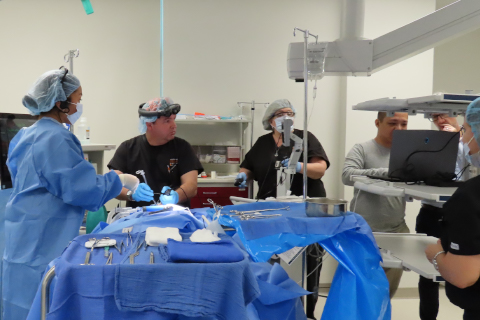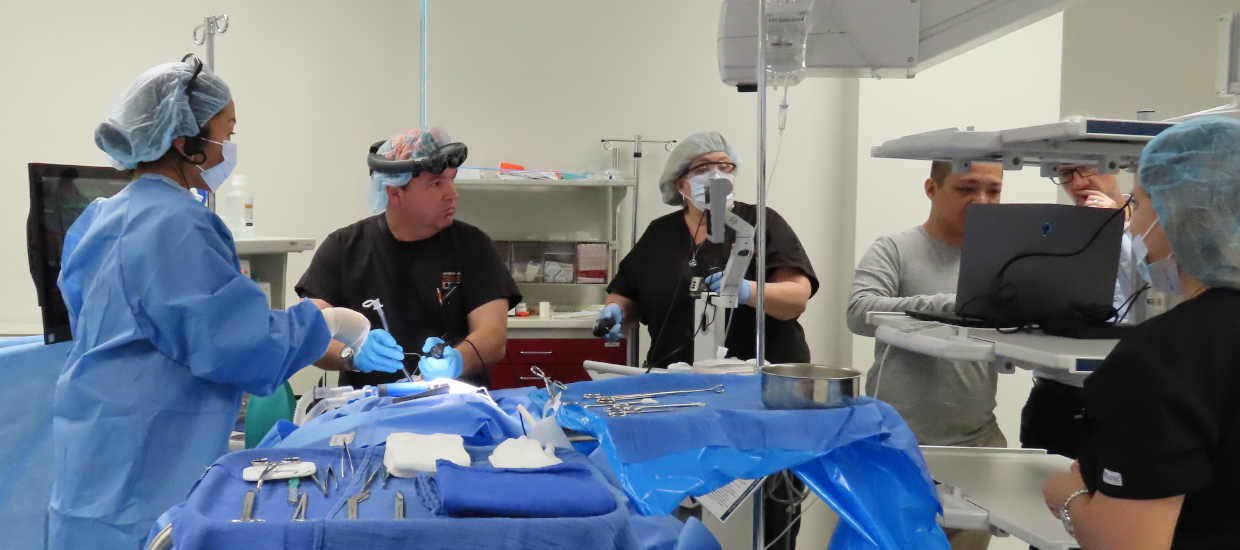Simulating rare but deadly airway fires that can ignite when patients receive oxygen via a throat tube used to be a tricky exercise at the University of Miami. Smoke alarms had to be turned off and a fire marshal stood by as professors activated a hidden smoke machine—which sometimes didn’t turn on as planned.
But no more. In the first Magic Leap project at the School of Nursing and Health Studies to be introduced into the curriculum, students in the nurse anesthesia program now have to react to both smoke and flames when learning how to prevent or extinguish an airway fire in one of the school's lifelike mannequin patients. Yet there is no real danger—nor need to shut down alarms or summon the fire marshal-because the smoke and flames are 3D holograms, visible only to students wearing Magic Leap's spatial computing goggles, whichmove 2-D computing to the 3-D world.
“This is a great opportunity to use Magic Leap goggles in a mixed reality, interactive scenario to train students to hopefully prevent fires. And, if they do have one, to know how to treat it," Juan E. Gonzalez, associate professor of clinical, said during the school’s third annual Simulation Symposium in February. "It's not something that happens all the time, but when it happens, it can have devastating consequences."
In all, the school has four Magic Leap projects underway. Like the airway fire project, two others were funded by Dean Cindy L. Munro's office. Both are still in the design phase, with critical help from the University of Miami Information Technology's Innovate team.
For one of those projects, Mary Mckay, associate professor of clinical, aims to put nursing students through a series of uncomfortable, augmented reality scenarios where they can learn how to identify and respond to incivility in the clinical workplace. Dealing with rude or disrespectful behaviors is an essential skill, Mckay said, because incivility is associated with increased absenteeism, nurse turnover, and medical errors.
For the other project in progress, Shayne Hauglum, assistant professor of clinical, is exploring how to livestream ultrasound images directly into Magic Leap headsets. His goal is to create a more ergonomic environment for sonographers. As the nurse anesthetist noted, sonographers often suffer neck pain because they have to assume awkward positions while running a handheld probe over a patient’s body and constantly look back and forth between the image on the ultrasound machine and the patient.
But, as excited as Hauglum was by the prospect of solving that problem, he was even more excited by the potential that Magic Leap founder Rony Abovitz sees for emerging technologies to bring the best information and health care to anyone, anywhere in the world. "It really opened up my eyes to the possibilities and expanded my wish list,” said Hauglum.
In his remarks at the symposium, Abovitz, a University of Miami alumnus who has turned his alma mater into a testing ground for Magic Leap's technology, described a world where the skills, knowledge, and presence of nurses and other health care practitioners will be amplified by spatial computing, artificial intelligence (AI), machine learning, the internet of things, and 5G networks.
For example, Abovitz said, nurses will be able to perform the work of 100 people because, instead of making physical rounds in a single hospital or seeing patients in a lone clinic, they'll make virtual rounds, popping in and out of numerous hospital rooms and clinics—not just in one place, but perhaps across Miami-Dade, Broward, and Palm Beach counties. And, they'll be accompanied by virtual AI assistants who see and know
everything because they can access thousands of similar examples that are happening around the world at that moment.
"They can query databases at super speeds that you can’t, and they’re using machine learning and vision recognition to say, 'Oh that's blood. That’s the face. These are the eyes,’” Abovitz added. "You, plus this group of technologies, will be a much more powerful entity than at any other time in human history," Abovitz told his audience.
"You become amplified by having superhuman sensing and machine vision capabilities that see what you see, hear what you hear, understand what you’re understanding.”
But until that future arrives, John Clochesy, Director of Evaluation and Strategic Initiatives and professor in the school, is content to see how Magic Leap's technology is benefitting nursing students, and whether the school's projects have market potential.
“We want to show we’re not only innovative, but that it has an impact on our students,” Clochesy said, urging the school’s faculty and staff to “think about what else we could be doing and where else we could use" Magic Leap's spatial computing platform.
As far as Gonzalez is concerned, he's already sold on Magic Leap's value in training future nurse anesthetists how to prevent or treat airway fires. "Students love it," he said. "They feel like it’s a realistic approach.”
For the school's fourth Magic Leap project, which received funding from Provost Jeffrey Duerk's office, Greta Mitzova-Vladinov, associate director of the nurse anesthesia program and associate professor of clinical, is using mixed reality to help students develop a systematic approach to setting up anesthesia suites, which in simulation trainings are too expensive to fully equip.





